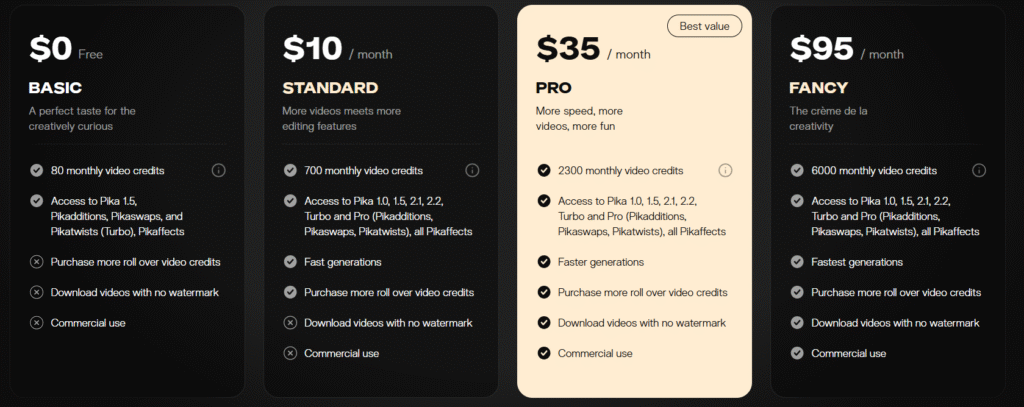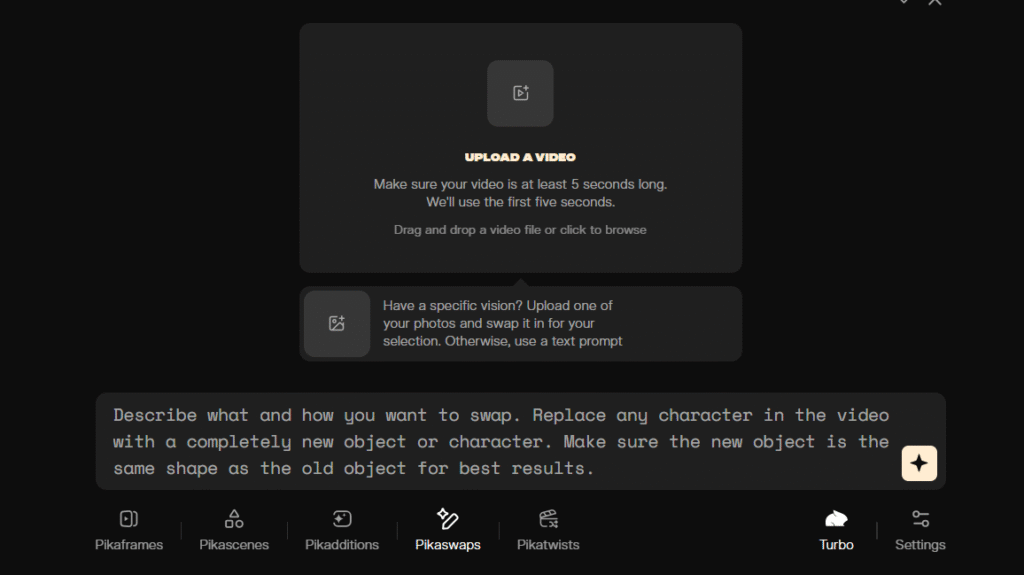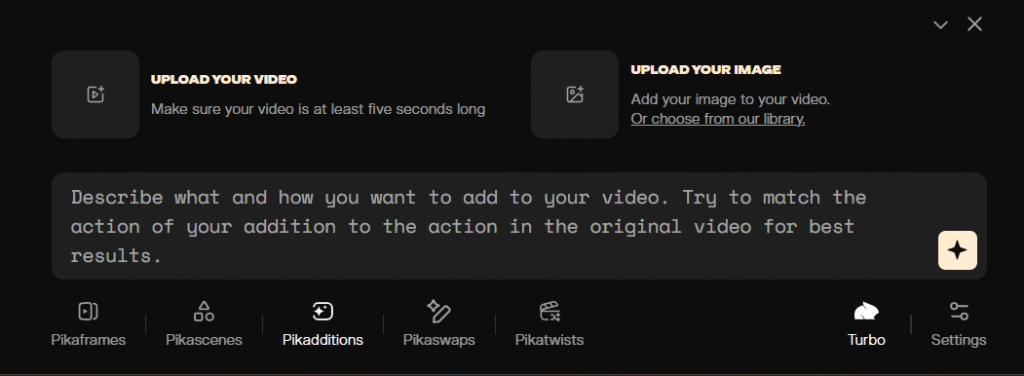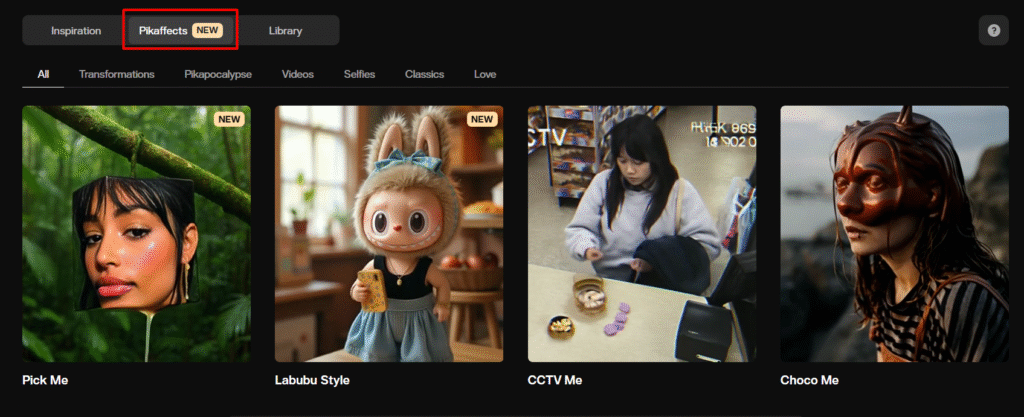Pika Labs AI Free Text to Video Generator | Pika Art
Pika Labs AI (Pika Art) is an innovative AI-powered platform that transforms ideas into videos. It specializes in text-to-video and image-to-video generation, making it accessible for creators, marketers, educators, and hobbyists to produce short, dynamic clips without advanced editing skills. Launched as part of the evolving AI video landscape, Pika Labs has gained popularity for its user-friendly interface and creative flexibility.
What is Pika Labs AI?
Pika Labs is an idea-to-video platform that uses artificial intelligence to generate short videos (typically 3-60 seconds) from text prompts, images, or a combination of both. It leverages advanced AI models to interpret descriptions and create visually engaging content, including animations, realistic scenes, and stylized effects. The tool is cloud-based, requiring no high-end hardware, and is accessible via web or mobile apps.
- Core Purpose: Democratize video creation by turning static ideas into motion, ideal for social media, marketing, storytelling, and experimentation.
- Key Differentiators: Focus on speed, customization, and integration of audio/visual elements, with recent shifts toward community-driven templates and social features.
Pika Labs started as a Discord-based tool in 2023 and has evolved into a full web/app platform with multiple versions (e.g., 1.0, 2.0, 2.1, 2.2). It’s developed by Pika Labs, a company emphasizing AI-driven creativity.
| Aspect | Details |
|---|---|
| Purpose | AI-powered platform for generating short videos (3-60 seconds) from text, images, or videos. |
| Core Features | – Text-to-Video, Image-to-Video, Video-to-Video – Scene Ingredients, Pikaframes, Pikadditions – Audio-driven lip-sync (August 2025) – Social hub for templates (September 2025) |
| Customization | Aspect ratios, FPS (24-60), styles (realistic, cartoon, cinematic), camera controls, negative prompts. |
| Editing Tools | Trim, crop, add text, color adjustments, sound effects, voiceovers, music integration. |
| Pricing Plans | – Free: Limited credits (~50/month), watermarks. – Starter: ~$10-20/month, no watermarks. – Pro: $58/month, unlimited generations, commercial use. – Business: ~$100+/month, team features. – Enterprise: Custom pricing, API access. |
| Platforms | Web (pika.art), iOS/Android apps. |
| Use Cases | Social media, marketing, storytelling, education, creative experimentation. |
| Pros | User-friendly, high-quality output, template hub, frequent updates. |
| Cons | Short video focus, rendering times vary, free tier limitations. |
| Alternatives | RunwayML, Kling AI, Luma Labs, Synthesia, HeyGen, Akool AI, Leonardo AI. |
| Community & Support | Discord, X (@pika_labs), in-app template hub; email support, blog tutorials. |
| Recent Updates | – September 2025: Social hub for templates. – August 2025: Audio-driven model. – February 2025: Pika 2.2 with Pikaframes, Pikadditions. |

History and Background of Pika Labs
Pika Labs was founded in 2023 by a team of AI enthusiasts aiming to simplify video production. It gained traction through its free Discord bot, allowing users to generate videos via simple commands. By 2024, it transitioned to a dedicated web platform (pika.art) with paid tiers. Key milestones include:
- 2023: Initial launch on Discord.
- 2024: Release of Pika 1.0 with text-to-video capabilities.
- Early 2025: Pika 2.0 introduced advanced features like Scene Ingredients for combining reference images.
- February 2025: Pika 2.2 update with Pikaframes for longer videos and Pikadditions for seamless video editing/additions.
- August 2025: Audio-driven performance model for hyper-real expressions and lip-sync.
The platform has raised significant funding and is positioned as a competitor to tools like RunwayML and Kling AI.
CEO of Pika Labs

The CEO of Pika Labs AI is Demi Guo, a Stanford Ph.D. graduate who co-founded the company in 2023 with a vision to make video creation accessible through generative AI.
Pika AI is a US-based company. It was founded in 2023 by Demi Guo and Chenlin Meng, two Stanford Ph.D. graduates.
Key Features
Pika Labs offers a robust set of tools for video generation and editing. Here’s a breakdown:
| Feature Category | Description |
|---|---|
| Generation Modes | – Text-to-Video: Convert descriptive prompts into videos. – Image-to-Video: Upload an image as a starting point to animate it. – Video-to-Video: Extend or modify existing clips. |
| Customization Options | – Aspect ratios, frames per second (FPS) for smoothness, video length. – Styles (e.g., realistic, cartoon, cinematic). – Camera controls (e.g., zoom, pan, rotate) via prompt keywords like “slow zoom-in”. – Negative prompts to exclude elements (e.g., “no blurry backgrounds”). |
| Editing Tools | – Trim, crop, add text/subtitles. – Color adjustments, sound effects, music integration. – Reprompting to iterate on generations. – Pikaframes (2025 update): Keyframing for longer, structured videos (e.g., aging effects, titles, transitions). |
| Audio Features | – Add voiceovers, music, or sound effects. – Recent audio-driven model (August 2025) for realistic lip-sync and expressions. |
| Advanced AI Capabilities | – Scene Ingredients: Combine multiple reference images (characters, objects, settings) into one scene. – Pikadditions (February 2025): Seamlessly add elements to existing videos. – Templates (September 2025 update): Browse community templates, create your own, and remix for quick starts. |
| Collaboration and Sharing | – Download in MP4 or other formats. – Direct sharing to social media (TikTok, Instagram). – Community hub for template sharing and inspiration. |
| Other | – Pika Bot: AI assistant for prompt suggestions. – Cross-device access (web, iOS/Android apps). – Commercial use rights on paid plans. |
Recent updates emphasize social aspects, turning Pika into a template-sharing platform where users can explore “tons of fun templates” or build custom ones.

How to Use Pika Labs AI: Step-by-Step Guide
This section outlines the process of creating videos using Pika Labs, based on the latest version (Pika 2.2 as of 2025).
Step 1: Navigating the Dashboard
The Pika Labs dashboard serves as the control center for video creation:
- Prompt Input: Enter text or upload images/videos to describe your desired video.
- Video Generation Settings: Customize aspect ratio, frame rate, and camera movements.
- My Library: Store, review, and edit your generated videos.
Step 2: Crafting Effective Prompts
Prompts are the backbone of Pika Labs’ AI video generation. A well-crafted prompt ensures the output aligns with your vision.
- Text Prompts: Use clear, descriptive language. For example, “A futuristic city at sunset with flying cars, vibrant neon lights, and a cinematic zoom-in.”
- Image Prompts: Upload a reference image to guide the AI’s visual style.
- Negative Prompts: Specify elements to exclude, e.g., “No blurry textures” or “No dark backgrounds.”
- Tips for Better Prompts:
- Be specific about details (e.g., “A golden retriever running on a beach” vs. “A dog”).
- Include style preferences (e.g., “realistic,” “cartoon,” “cyberpunk”).
- Mention camera movements (e.g., “slow pan across a forest”).
Step 3: Configuring Video Settings
Customize your video for optimal results:
- Aspect Ratio: Choose from 16:9 (widescreen), 9:16 (vertical), 1:1 (square), etc., based on your platform (e.g., YouTube, Instagram).
- Frame Rate: Select 8–24 fps; higher rates (e.g., 24 fps) ensure smoother playback.
- Camera Movements: Add pan, tilt, zoom, or rotate for dynamic effects.
- Seed Value: Adjust for varied results with the same prompt; leave blank for random generation.
- Duration: Set video length, typically 3–10 seconds for short-form content.
Step 4: Generating the Video
- Enter your prompt and adjust settings.
- Click “Generate” or “Enter” to start the AI processing.
- Wait for real-time rendering (usually a few seconds to minutes, depending on complexity).
- Review the output in “My Library.”
Step 5: Editing and Refining
- Modify Region: Select specific parts of the video to revise or enhance.
- Pikaswaps: Swap objects or people in the video (e.g., replace a car with a spaceship).
- Pikaffects: Apply effects like “Inflate It” or “Melt It” for creative modifications.
- Lip Sync: Add synchronized dialogue for realistic character interactions.
- Upscale/Extend: Increase resolution or extend video length for refined output.
Step 6: Saving and Sharing
- Save videos to “My Library” for future edits.
- Share directly via links or download for posting on social media platforms.
Pricing Plans of Pika Labs AI
Pika Labs uses a credit-based system (credits deducted per generation). :

| Plan | Monthly Cost (Billed Yearly) | Monthly Credits | Approx. Videos per Month (Basic) | Effective Cost per Video |
|---|---|---|---|---|
| Free | $0 | 80 | ~8 (then limited/no more gens) | $0 (until credits run out; watermarks apply) |
| Standard | $8 | 700 | ~70 | ~$0.11 |
| Pro | $28 | 2,300 | ~230 | ~$0.12 |
| Fancy | $76 | 6,000 | ~600 | ~$0.13 |
In Pika Labs AI, there’s no fixed dollar amount for generating a single video—instead, it uses a credit-based system where each generation deducts credits based on factors like the model (e.g., Turbo, 2.2, Pro), video length (typically 3-10 seconds), resolution (720p or 1080p), and features (e.g., text-to-video vs. advanced effects). Credits come with your subscription plan, and you can buy extras if you run out. This keeps things flexible but means the “cost” per video varies.
How Credits Work for a Single Video
- Basic generations (e.g., simple text-to-video or image-to-video without extras): Start as low as 5-6 credits for Turbo model at 720p (short clips).
- Standard generations (e.g., 2.2 model, 5-10 seconds): 6-12 credits at 720p or 18-45 credits at 1080p.
- Advanced features (e.g., Pikascenes or Pikaframes): 15-35 credits at 720p or up to 100-125 credits for longer/higher-res clips.
- Videos with effects like Pikatwists can hit 60-80 credits, while Pikaffects might add 15-80 credits depending on input type.
For context, a typical short video (5 seconds, 720p, basic text-to-video on 2.2) costs about 6-18 credits. If you’re on a paid plan, this translates to a fractional cost (e.g., pennies per video), but on the free tier, you’ll hit limits fast.
5 credits – Turbo model (image or text-to-video)
10 credits – Turbo model (using Pikascenes, Pikadditions or Pikaswaps)
60 credits – Turbo model (using Pikatwists)
15 credits – 1.0/1.5 model
35 credits – 2.1 model (image or text-to-video)
60 credits – 2.1 model (using Pikascenes)
20 credits – Pro model (using Pikadditions or Pikaswaps)
30 credits – Pro model (using Selfie With Your Younger Self template)
80 credits – Pro model (using Pikatwists)
Subscription monthly video credits do not roll over from month to month.
New 2.2 Model
See pricing table below based on generation type, duration, and resolution
| Generation Type | 5 seconds | 10 seconds |
|---|---|---|
| Pikaframes | 8 credits (720p)25 credits (1080p) | 15 credits (720p)60 credits (1080p) |
| Image-to-Video or Text-to-Video | 6 credits (720p)18 credits (1080p) | 12 credits (720p)45 credits (1080p) |
| Pikascenes | 15 credits (720p)35 credits (1080p) | 30 credits (720p)100 credits (1080p) |
| Generation Type | 0-5 seconds | 5-10 seconds | 10-15 seconds | 15-20 seconds | 20-25 seconds |
|---|---|---|---|---|---|
| Pikaframes | 8 credits (720p)25 credits (1080p) | 15 credits (720p)60 credits (1080p) | 25 credits (720p)75 credits (1080p) | 30 credits (720p)100 credits (1080p) | 35 credits (720p)125 credits (1080p) |
Feature-Specific Costs
Pikadditions: 10 credits (Turbo) / 20 credits (Pro)
Pikaswaps: 10 credits (Turbo) / 20 credits (Pro)
Pikascenes (2.1): 60 credits
Pikascenes (Turbo): 10 credits
Pikatwists (Turbo): 60 credits (Turbo) / 80 credits (Pro)
Selfie With Your Younger Self (Pro): 30 Credits
Pikaffects: 15 credits Image-to-Video / 80 credits Video-to-Video
Pricing Plans and Effective Cost Per Video
Plans give you a monthly credit allowance—no rollovers for subscriptions, but you can buy add-ons (e.g., $10 for 700 extra credits). Here’s a quick table of plans and rough cost estimates for a basic 5-second video (assuming ~10 credits average for 2.2 model at 720p)
Advanced Features and Techniques
Pikaframes
Pikaframes allow frame-by-frame control, ideal for detailed animations or storyboards. Users can generate sequential frames and fine-tune each for precise storytelling.

Pikaswaps
This feature enables object or character replacement in videos. For example, swap a person in a selfie with a younger version of themselves for creative storytelling like “Selfie With Your Younger Self.”

Pikadditions
Add new elements to existing videos, such as inserting a character or object into a scene, enhancing engagement and creativity.

Pikaffects
Apply unique effects to alter video aesthetics:
- Inflate It: Expands objects for a whimsical effect.
- Melt It: Creates a surreal, melting visual.
- Pikapocaylpse: Adds dramatic, apocalyptic transformations.

Lip Sync Tool
The native AI Lip Sync tool synchronizes dialogue with character movements, making videos more lifelike. This is particularly useful for animated storytelling or dubbing.
Camera Movement Commands
Enhance videos with cinematic effects:
- Pan: Horizontal camera movement for wide scenes.
- Zoom: Focus on specific details.
- Tilt: Vertical angle adjustments.
- Rotate: Circular camera motion for dynamic shots.
Use Cases for Pika Labs AI
Pika Labs is versatile, catering to various industries and creative needs:
- Content Creators: Produce engaging short-form videos for TikTok, Instagram Reels, or YouTube Shorts.
- Marketers: Create promotional videos or ads without expensive production.
- Educators: Animate lessons or concepts for interactive learning.
- Storytellers: Craft narrative-driven animations or cinematic scenes.
- Social Media: Generate viral content like Pikamemes, blending humor and pop culture.
Best Practices for Optimal Results
- Prompt Precision: Use detailed, specific prompts to guide the AI effectively.
- Iterative Refinement: Experiment with settings and revise outputs using “Modify Region” or Pikaswaps.
- Test Multiple Seed Values: Generate variations to find the best result.
- Leverage Community Resources: Explore the Pika Labs Community for sample prompts and inspiration.
- Stay Updated: Check for new features like Pika 2.2 updates for enhanced realism and functionality.
Pros and Cons
From user experiences and testing:
Pros:
- Intuitive interface; no steep learning curve.
- High-quality, dynamic videos in seconds.
- Versatile for industries (marketing, education, entertainment).
- Strong community features (templates, sharing).
- Frequent updates improve realism and control.
Cons:
- Limited to short videos; not ideal for full-length films.
- Rendering times can vary (longer for complex prompts).
- Free tier has restrictions (watermarks, low credits).
- Dependent on internet; occasional inconsistencies in AI interpretations.
- Higher plans are pricey for casual users.
Alternatives of Pika Labs AI
If Pika doesn’t fit, consider these (based on similar features):
- RunwayML: Advanced text-to-video with Gen-4 Turbo for speed; great for pros.
- Kling AI: Superior quality in 2025 updates; focuses on cinematic effects.
- Luma Labs (Dream Machine): Strong image-to-video; free tier available.
- Hailuo AI (MiniMax): Audio-driven features; good for lip-sync.
- HeyGen: AI avatars and voiceovers.
- Akool AI: Versatile editing.
- Leonardo AI: More image-focused but with video extensions.
- Pixverse: Budget-friendly animations.
Pika stands out for its template hub and ease of use.
Pikaffects by Pika (IOS app)
https://apps.apple.com/us/app/pikaffects-by-pika/id6680155400


Community and Support of Pika Labs
- Community: Active on Discord (original home), X (Twitter), and the in-app social hub for templates. Users share prompts, templates, and feedback.
- Support: Email/ticket system; priority for paid users. Check the blog (blog.pika.art) for tutorials and updates.
- Resources: YouTube tutorials (e.g., “Pika Labs 2.2 Hands-On”), official docs, and community forums for troubleshooting.
Recent Updates of Pika Labs
- September 2025 Redesign: New interface, features, and concepts; now a social hub for AI templates. Users can browse, remix, and create templates (e.g., for effects or styles).
- August 2025: Audio-driven performance model for hyper-real expressions and lip-sync.
- February 2025: Pika 2.2 with Pikaframes and Pikadditions for editing/additions.
- Ongoing: Improved inference SDK, storage tools, and CLI for developers; focus on customization.
For the latest, visit pika.art or follow @pika_labs on X.
Is Pika Labs AI Free?
Yes, Pika Labs offers a free tier with limited credits (~50/month) and watermarks. Paid plans start at ~$10-20/month.
Who is the CEO of Pika AI?
Demi Guo, a Stanford Ph.D. graduate, is the co-founder and CEO of Pika Labs, driving its vision since 2023.
How to Use Pika AI for Free?
Sign up at pika.art, use the free tier to generate videos with basic features, and explore community templates.
Which Country Made Pika AI?
Pika Labs was founded in the United States.
How Much Does Pika AI Cost?
Plans range from free to $58/month (Pro) or $100+/month (Business). Check pika.art for details
What is Pika 2.2?
Pika 2.2, released in February 2025, is the latest version of Pika Labs AI, introducing advanced features for better control and creativity. It builds on Pika 2.0 with tools like Pikaframes for keyframing and Pikadditions for seamless video edits. It’s ideal for crafting longer, structured videos with effects like transitions or aging sequences, making it a favorite for storytellers and marketers.
Key Features:
- Pikaframes: Create keyframes for dynamic sequences.
- Pikadditions: Add elements to existing videos seamlessly.
- Enhanced rendering for smoother, higher-quality outputs.
PikaTwists by Pika Labs
PikaTwists is a creative feature in Pika Labs that lets you remix existing videos with new styles or effects. Think of turning a realistic clip into a cartoon or adding a sci-fi vibe to a simple scene. It’s perfect for experimenting with fresh looks without starting from scratch.
Key Features:
- Apply stylistic changes to videos.
- Quick transformations with one click.
- Combine with templates for faster results.
Pika 2.2 is Available Now!
Pika 2.2 is live as of February 2025, bringing Pikaframes and Pikadditions to all users. The update also improves rendering speeds and adds support for community-driven templates, making it easier to create and share unique videos. Check it out on pika.art (nofollow).
Pikaframes by Pika Labs
Pikaframes is a standout feature in Pika 2.2, allowing users to set keyframes for structured video sequences. Want a character to age over time or a title to fade in? Pikaframes makes it possible with precise control over transitions and effects.
Key Features:
- Keyframe-based editing for dynamic sequences.
- Support for transitions, titles, and motion effects.
- Easy integration with other Pika Labs tools.
PikaSwaps by Pika Labs
PikaSwaps lets you swap elements in a video, like changing a character’s face or replacing a background. It’s a powerful tool for quick edits, especially for marketing or social media content where you need to tweak visuals fast.
Key Features:
- Swap characters, objects, or backgrounds.
- Maintain video quality during edits.
- User-friendly interface for quick changes.
Pikamemes by Pika.art
Pikamemes is a fun feature on Pika Labs for creating meme-style videos. It combines text-to-video with humorous templates, perfect for viral social media content. Users can generate quick, shareable clips with minimal effort.
Key Features:
- Pre-built meme templates for fast creation.
- Customizable text and effects.
- Direct sharing to platforms like TikTok.
Key Features of Pika 2.0
Pika 2.0, launched in 2024, introduced core tools that remain central to Pika Labs. Here’s a breakdown:
1. Ingredients Feature
The Ingredients feature lets you combine multiple reference images (characters, objects, settings) into one cohesive video scene. It’s like building a visual recipe for your video.
How to Use Ingredients:
- Upload images for characters, backgrounds, or props.
- Combine them in the Pika Labs interface.
- Adjust their placement and interaction via prompts.
2. Templates for Quick Creation
Templates allow you to start with pre-designed video styles or effects, recently enhanced in the September 2025 update with a social hub for community templates.
How to Use Templates:
- Browse the template hub on pika.art.
- Select a template (e.g., ink splash effect).
- Customize with your text or images.
3. Pika Effects
Pika Effects add flair to your videos, like slow-motion, color grading, or stylized filters (e.g., cartoon, cinematic).
Applying Pika Effects:
- Choose an effect from the Pika Labs menu.
- Adjust intensity or duration.
- Preview and apply to your video.
New Feature: Pikadditions
Pikadditions, introduced in February 2025, lets you seamlessly add new elements to existing videos, like inserting a character or object without disrupting the flow. It’s ideal for iterative editing and refining clips.
Prompt library — Pika Art AI
- “Cinematic closeup of a vintage watch winding, slow dolly in, warm tungsten light.”
- “Tiny robot watering bonsai, stop-motion toy feel, slow pan, soft shadow.”
- “Product reveal: new wireless earbuds floating on marble, 3s spin, spec overlay.”
- “Macro: frosty leaf in the morning sun, dewy bokeh, gentle pull back.”
- “PikaTwist: balloon dog inflating into a cake, loop, playful.”
How to structure prompts for the best results (practical tips)
- Start with medium & style (e.g., “cinematic 35mm” or “stop-motion toy style”).
- Add subject & action (who/what does what).
- Add camera & motion (dolly, pan, orbit, zoom).
- Add lighting & mood (golden hour, fog, neon).
- Keep it concise and layered — short sentences often work better than long paragraphs.
- Use negative prompts to remove artifacts (“no extra limbs, no text overlay”).
Examples:
- “Stop-motion vinyl figure walking across a mint kitchen counter, slow pan, soft backlight.”
- “Macro of a dew droplet on grass, sunrise, very shallow DOF, gentle pull back.”
Pika Turbo: The Fastest Mode in Pika Labs AI
Pika Turbo is the newest speed-focused mode in Pika Labs AI (also known as Pika Art), launched on January 30, 2025. It lets creators generate high-quality AI videos up to 3x faster and at 7x lower credit cost compared to standard models like Pika 2.2 or Pro. Ideal for quick content like memes, TikToks, or prototypes, it supports text-to-video (T2V), image-to-video (I2V), and the Ingredients feature for character consistency. Pika Turbo makes AI video creation more affordable and efficient, perfect for daily creators who need rapid iterations without sacrificing visual appeal.
Key Features of Pika Turbo
- Ultra-Fast Rendering: Under 1 minute per video, 3x faster than Pro.
- Low Credit Cost: 5-18 credits per generation (7x savings).
- Multi-Input Support: Works with T2V, I2V, and Ingredients for consistent elements.
- Quality Retention: Maintains high-res outputs suitable for social media or prototypes.
- Mobile Accessibility: Now on iOS for on-the-go editing with Pikaffects.
Pika Labs AI Features
- Text-to-Video: Generate videos from descriptive prompts.
- Image-to-Video: Turn static images into dynamic clips.
- Video Editing: Modify videos with Pikaswaps or Pikadditions.
- Lip Sync: Sync dialogue with characters for realism.
- Camera Controls: Add pan, zoom, or tilt for cinematic shots.